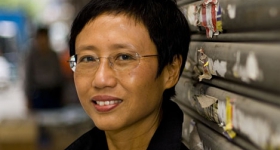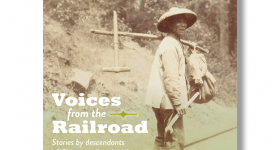By Eric Zhang
Burlee Vang, founder of The Hmong American Writers’ Circle, explains that “Some say we had a written language, believed to have been lost from forced assimilation under Imperial China thousands of years ago.” In light of a scarce written canon, the Hmong American contributors to the anthology How Do I Begin? seek to recover cultural heritage and challenge their marginalization within more mainstream Asian American literature.
The material contained within demonstrates a wide range of styles and themes, although highly personal and semi-autobiographical narratives of everyday experiences, especially within a familial context, take center stage. A few authors incorporate mythology and history in relation to modern characters, like Ka Vang, whose protagonist Pao adopts a WWF persona based on the ancient shaman Shee Yee. However, most writers choose not to introduce mythical elements to their narratives, in favor of more visceral and emotional relationships between husbands and wives, parents and children, brothers and sisters, friends and strangers.
While each writer brings a unique and culturally significant insight into the lives of often disadvantaged Hmong American youth and families, some fall prey to tired tropes common to other Asian American texts. Those more noteworthy, standing out from the crowd, include Burlee Vang, Mai Der Vang, Pos L. Moua, and Mai Neng Moua, who all write with such raw sincerity that I am left haunted by their words.
Burlee Vang’s “Mrs. Saichue,” which is in my opinion one of the most compelling stories in the collection, follows a married couple who choose an unconventional solution to the eponymous character’s infertility. Focusing on Mrs. Saichue’s apprehension concerning her domestic situation, Vang ponders the words left unspoken in her relationships. “The other housewives have come to address her only by her husband’s name,” he writes, “no doubt a polite and customary formality for persons of no relation -- but an indication of impersonal distance nonetheless.” Mrs. Saichue’s inability to voice her concerns to her husband further underscores a central tension that persists throughout the anthology between societal expectations and personal desires. She fears that the concessions she makes to fulfill her duty as a wife by providing a child has created a rift in her marriage.
Likewise, in Mai Neng Moua’s story “Being a Nyab,” a young wife must face the expectation that she, as a nyab or daughter-in-law, will be forced to take care of her husband’s overbearing aunt Phauj Mee. “I didn’t know how to bridge the gap between my feminist self and the submissive Hmong girl Niam [mother] had taught me to be.” When Phauj Mee rejects a bowl of pho for lunch, the protagonist must choose between letting her eat a “poor man’s lunch” or compromising her independence by cooking a new dish, an act she fears will doom her to forever serving Phauj Mee. Moua successfully transforms an otherwise mundane experience into a tense battle between not just two women, but two opposing beliefs about femininity and tradition.
Pos L. Moua and Mai Der Vang both similarly take small moments and infuse them with abounding significance. Moua’s poem “The Ant and the Fire-Woman” is an Aesop’s fable of sorts, featuring a firefighter trainer (the “Fire-Woman”) who orders an ant-sized man to climb up a hill with a heavy fire hose. Its ambiguous, futile ending, however, seems to lack an easily discernible moral: “and i, tiny little ant, / quickly head uphill / only to roll back down / like all sorts of fat animals,” Moua writes. Vang’s poem “Your Janitor: Is My Father” takes on a similarly resigned tone as she writes about a Hmong janitor and his work cleaning up after white-collar office workers. For Vang’s janitor father, the empty hallways represent not just an office building, but moreover the disjuncture between the visibility of the office employees and the invisibility of the janitor. “The clock in the break room / spinning, / ticking, / full stress, / still, rows beyond,” Vang writes, suggesting the endlessness of her father’s unappreciated work.
In prefaces to their poems and stories, the authors are all given an opportunity to introduce themselves and the relationship between their writing and their ethnicity. Some consider themselves a Hmong first and a writer second, others a writer first and a Hmong second. Their own individual experiences and multiple identities, too, add depth to their writing. For example, Mai Neng Moua, mentioned above, writes from a conflicted feminist perspective, while Ying Thao’s queer identity informs his writing. The inclusion of non-Hmong writers like Anthony Cody further complicates the diversity within the volume by adding voices that, though they may not share the same experiences, have in some way been impacted by the Hmong American community. Lastly, the book also features the works of Hmong painters and photographers, which enrich the text by making the faces of these Hmong characters and individuals all the more visible.
Ultimately, How Do I Begin? is an invaluable addition to Asian American literature. The writers and artists highlighted throughout the book attest to the diversity of experiences within the Hmong American community, revisiting themes common to Asian American literature as well as introducing imagery and perspectives that have not previously been addressed in the mainstream.
Eric Zhang has a background in Asian American studies, art, and visual culture. He currently lives in New York, where he works at NYU and MOCA.









Comments